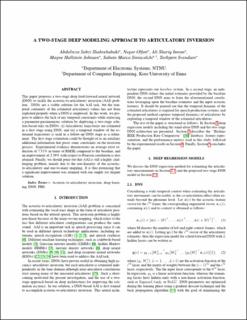A Two-Stage Deep Modeling Approach to Articulatory Inversion
Sabzi Shahrebabaki, Abdolreza; Olfati, Negar; Imran, Ali Shariq; Johnsen, Magne Hallstein; Siniscalchi, Sabato Marco; Svendsen, Torbjørn Karl
Chapter
Accepted version

Åpne
Permanent lenke
https://hdl.handle.net/11250/3025349Utgivelsesdato
2021Metadata
Vis full innførselSamlinger
Originalversjon
2021 IEEE International Conference on Acoustics, Speech and Signal Processing (ICASSP) 10.1109/ICASSP39728.2021.9413742Sammendrag
This paper proposes a two-stage deep feed-forward neural network (DNN) to tackle the acoustic-to-articulatory inversion (AAI) problem. DNNs are a viable solution for the AAI task, but the temporal continuity of the estimated articulatory values has not been exploited properly when a DNN is employed. In this work, we propose to address the lack of any temporal constraints while enforcing a parameter-parsimonious solution by deploying a two-stage solution based only on DNNs: (i) Articulatory trajectories are estimated in a first stage using DNN, and (ii) a temporal window of the estimated trajectories is used in a follow-up DNN stage as a refinement. The first stage estimation could be thought of as an auxiliary additional information that poses some constraints on the inversion process. Experimental evidence demonstrates an average error reduction of 7.51% in terms of RMSE compared to the baseline, and an improvement of 2.39% with respect to Pearson correlation is also attained. Finally, we should point out that AAI is still a highly challenging problem, mainly due to the non-linearity of the acoustic-to-articulatory and one-to-many mapping. It is thus promising that a significant improvement was attained with our simple yet elegant solution.